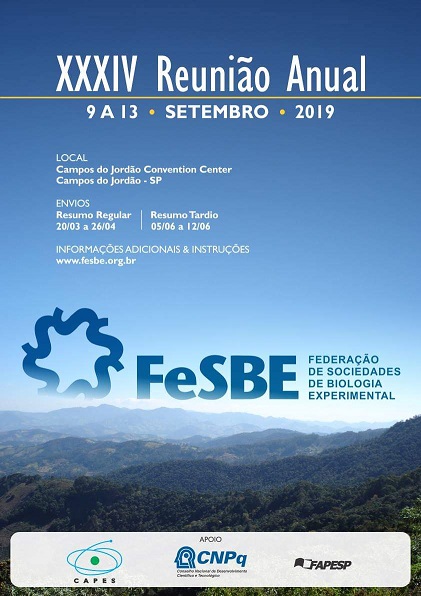A XXXIII Reunião Anual da FeSBE acontecerá entre os dias 9 e 13 de setembro de 2019, no Centro de Convenções em Campos do Jordão, São Paulo.
PRAZOS PARA RESUMOS:
Envio regular: 27 de março a 6 de maio (resumo pode ser corrigido e concorre a premiações)
Envio tardio: 5 a 12 de junho (resumo não pode ser corrigido)
TEMAS PARA RESUMOS:
1. Ambiental Biology, Evolution and Comparative Biology
2. Anatomy
3. Laboratory Animal Science
4. Cardiovascular Biology and Diseases
5. Gastrointestinal Biology and Diseases
6. Endocrine System
7. Nutrition and Metabolism
8. Renal Biology and Diseases
9. Respiratory Biology and Diseases
10. Neurobiology
11. Physical Training Responses
12. Biomembranes, Transporters and Signaling
13. Cell differentiation, growth and death
14. Nuclear Biosciences for Health – ÁREA DA SBBN
15. Optical and Mechanical Technologies for Health – ÁREA DA SBBN
16. Gene and Cell Therapy, Omics Biology
17. Basic & Clinical Pharmacology
18. Neuropsychopharmacology
19. Toxicology
20. Pain and Inflammation
21. Immunology
22. Cancer Signaling and Therapeutics
23. Regenerative Medicine and Developmental Biology
24. Vision and Ophthalmology
25. Education, Science History and Philosophy, Science Communication
26. FeSBE Jovem
INSCRIÇÕES: Descontos nas inscrições para associados adimplentes (todas as anuidades, inclusive 2019)
Inscreva-se em: http://www2.fesbe.org.br/eventos/fesbe-anual-2019/inscricao/
PROGRAMA:
Cerca de 60 atividades, entre conferências, simpósios, cursos e módulos temáticos.
Programa completo:programa-preliminar-fesbe-2019-para-divulgacao_02-04-19
CONFERÊNCIAS: São oferecidas 12 conferências (60 min). Destaques:
ENVIRONMENTAL REMEDIATION IN URANIUM MINING AND NORM – oferecida pela SBBN
Prof. HORST MONKEN-FERNANDES NUCLEAR ENERGY DEPARTMENT/INTERNATIONAL ATOMIC ENERGY AGENCY (IAEA)
Environmental remediation of radioactive contamination is about achieving appropriate reduction of exposures to ionizing radiation. This goal can be achieved by means of isolation or removal of the contaminant sources or breaking the exposures pathways. Ideally, environmental remediation is part of the planning phase of any industrial operation with the potential of to cause environmental contamination. The lessons learned from international experience can help the Brazilian authorities and scientists of more sustainable options in the development of the future uranium production sites.
Pericytes at the intersection between tissue regeneration and pathology – oferecida pela SBBN
Prof. Alexander Birbrair, ICB/UFMG
Paper recently published by Alexander Bribrair in Stem Cells Translational Medicine showed that the neural stem cell derived from the muscular pericyte and of the skeletal muscle blood vessel cell, has natural attraction for substances produced by tumor. This finding may constitute a good strategy for the treatment of glioblastoma.
OUTROS DESTAQUES:
Non‐coding RNAs: pathophysiological role and clinical application in the cardiovascular system. Prof. Da‐Zhi Wang (Harvard Medical School)
Short description: Dr. Wang’s laboratory focuses on the molecular mechanisms of cardiac, smooth and skeletal muscle development and diseases. They identified a subset of miRNAs that are specifically expressed in cardiac and skeletal muscles that play a critical role in controlling cardiac and skeletal muscle proliferation and differentiation. Dr. Wang is a highly productive and innovative scientist and have published in Cell, Nature,
Nature Genetics, Nature Medicine, PNAS, Journal of Clinical Investigation, Development, Circulation and Circulation Research.
A Chimera Named Pollution. Prof. Walter Araujo Zin (UFRJ)
Short description: Pollution has many faces and needs a multitude of approaches to be minimized. Indoor pollution, particulate matter in general, Diesel engines exhaust products, and plastics in water collections will be the main topics to be discussed by Prof. Zin who published over 200 papers in the field.
SIMPÓSIOS:São oferecidos 21 simpósios. Destaques:
RISKS TO ENVIRONMENTAL AND HEALTH DUE TO THE URANIUM MINING IN BRAZIL – oferecido pela SBBN
Nuclear fuel cycle in Brazil, Prof. AQUILINO SENRA (COPPE/UFRJ)
Biological effects of chronic exposures in the neighbourhood of nuclear fuel cycle facilities, Prof. Dunstana Melo (Melohill Tecnology, USA)
Immunomodulators and intestinal homeostasis – oferecido pela SBBN
Probiotic Bacteriophages- A novel strategy to control infection and inflammation, Prof. LUIS RICARDO GOULART (Universidade Federal de Uberlândia)
Use of lactic acid bacteria genetically modied as immunomodulators to promote intestinal homeostasis, Prof. Vasco Ariston Carvalho de Azevedo (Depto de Biologia Geral/ICB/UFMG)
CURSOS – são oferecidos 17 cursos, durante 3 dias, com 50 min/dia, totalizando CH 3 horas. Destaques:
Imagens de bases moleculares – oferecido pela SBBN
Coordenador: Prof. Valbert Nascimento Cardoso (UFMG)
Imagens cintilográficas PET e SPECT, Prof. Simone Odilia Antunes Fernandes (UFMG)
Nanoformulações para diagnóstico por imagens, Prof. Valbert Nascimento Cardoso (UFMG)
Nanoformulações para tratamento, Prof. Valbert Nascimento (UFMG)
Redação Científica: Artigos, Projetos e Ética. Coordenador: Walter Araujo Zin (UFRJ)
How to make the most of optical microscopy. Coordenador: Manoel Luis Costa (UFRJ)
Modelagem animal: o que preciso fazer para ter resultados precisos. Coordenador e Professor: Marcel Frajblat (UFRJ)
Bioimpressão 3D na Medicina Regenerativa. Coordenadora e Professora: Marimelia Porcionatto (UNIFESP)
Imprimindo tecidos e órgãos: biotintas e células
MÓDULOS TEMÁTICOS – São oferecidos 12 módulos, compostos de 2 palestras e 2 comunicações orais. Destaque para:
Neuroscience of learning and Brazilian education
Chair: Camilo Lellis‐Santos (UNIFESP)
Science for education: a window of opportunity for Brazil, Robert Lent (UFRJ)
Universal design for learning: accommodating individual learning differences, Claudia Berlim de Mello (UNIFESP)
FeSBE Jovem (dias 11, 12 e manhã do dia 13)
É um espaço dedicado aos estudantes do ensino médio). A SBBN oferece o curso Curso A proteção do ser humano em situações de acidentes biológicos, químicos e radioativos e em ataques terroristas
Aula 1: Aplicações da Física Nuclear e possíveis impactos para o ser humano, Silvia M. Velasques de Oliveira
Aula 2: Experiências de remediação do impacto ambiental em acidentes nucleares, Horst Monken-Fernandes (IAEA, Vienna)
Aula 3: Como funcionam os laboratórios de Defesa Nuclear, Biológica, Química e Radiológica, Edson Ramos de Andrade (Instituto de Engenharia Nuclear, IEN/CNEN)
